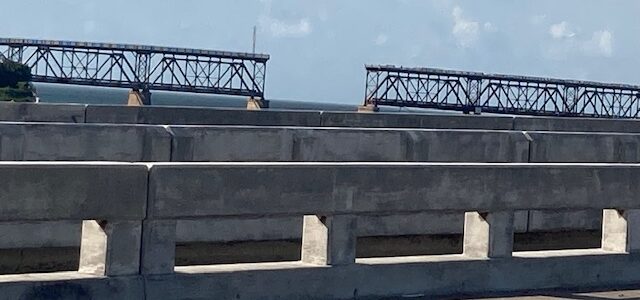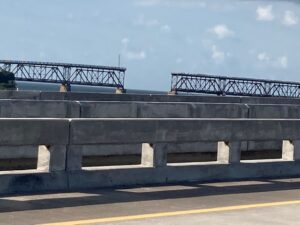
Crash Guards Demonstrate the Force of Cars’ Impact
How hard is a crash at highway speed? When driving in your car, you are probably not thinking about momentum, forces, or physics. While this may not be on our mind, highway designers and engineers are constantly working to calculate the forces of the impacts that may occur. A car is essentially a small tank; with its speed and mass, momentum is constantly at play.
The equation for calculating momentum = mass x speed(velocity).
Question: What is the momentum of a 1500 kg car going at highway speed of 28 m/s (about 100 km/h or 60 mph)?
Answer : 1500 kg × 28 m/s · = 42,000 kg m/s or 84,490.81 pounds per yard per second. OR, worse yet, 42.245 TONS per yard per second.

This is an enormous amount of force that can cause major damage to vehicles, roadways, railings, and horrific injuries to humans. While air bags and seat belts offer some protection, they are not perfect. When you look at the robust materials and thickness of road crash barriers, you realize that a car door is not much protection in a “T-bone” collision.
In a case at ABRAMS LANDAU, the team assisted a female driver who got burns from the propellant that exploded from the air bag in the steering wheel. The collision was not on an interstate highway, but at a modest speed. Female drivers are often shorter than male, so the burns around the periphery of her face were not unusual. Women sit closer to the steering wheel, and their arms are shorter, forcing them to be closer to the impact. Airbags may save lives, but they can also cause burns or chemical skin irritations. These are additional injuries that the unsafe driver who caused the crash should reimburse the innocent victim for by settlement, mediation, or trial.
Because the forces involved in car crashes are often significant, the final positions of the vehicles can make determining where individuals were at impact difficult. The ABRAMS LANDAU car crash team has helped motorists who were struck so hard that their cars ended up upside down in the lanes of oncoming traffic or, on their sides, with the occupants hanging by their safety lap belts and shoulder restraints! The investigating police officers can use skid marks, yaw marks, car pieces in the “debris field,” and other physical evidence from the crash site to try to piece together what happened. This evidence also helps law enforcement with issuing citations for causing the crash, injuries, and damage to property. In some cases, there are explosions that destroy evidence, which makes it difficult to prove the case. In other instances, where the injured victims or their families have reached out to Lawyer Doug Landau right away, the ABRAMS LANDAU team has been able to get copies of the intersection camera footage, surveillance images, and/or videos. This evidence is then all compiled in order to make the civil negligence case on behalf of the injured victims.

If you or someone you care for has questions about the laws regarding highway crash injuries or experienced a car crash, please do not hesitate to call us at (703) 796-9555 or email frontdesk@landaulawshop.com right away!
